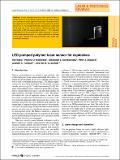LED pumped polymer laser sensor for explosives
Abstract
A very compact explosive vapor sensor is demonstrated based on a distributed feedback polymer laser pumped by a commercial InGaN light-emitting diode. The laser shows a two-stage turn on of the laser emission, for pulsed drive currents above 15.7 A. The 'double-threshold' phenomenon is attributed to the slow rise of the ∼30 ns duration LED pump pulses. The laser emits a 533 nm pulsed output beam of ∼10 ns duration perpendicular to the polymer film. When exposed to nitroaromatic model explosive vapors at ∼8 ppb concentration, the laser shows a 46% change in the surface-emitted output under optimized LED excitation. A very compact explosive vapor sensor is demonstrated based on a distributed feedback polymer laser pumped by a commercial InGaN light-emitting diode. The laser shows a two-stage turn on of the laser emission, for pulsed drive currents above 15.7 A. The 'double-threshold' phenomenon is attributed to the slow rise of the ∼30 ns duration LED pump pulses. The laser emits a 533 nm pulsed output beam of ∼10 ns duration perpendicular to the polymer film. When exposed to nitroaromatic model explosive vapors at ∼8 ppb concentration, the laser shows a 46% change in the surface-emitted output under optimized LED excitation.
Citation
Wang , Y , Morawska , P O , Kanibolotsky , A L , Skabara , P J , Turnbull , G A & Samuel , I D W 2013 , ' LED pumped polymer laser sensor for explosives ' , Laser & Photonics Reviews , vol. 7 , no. 6 , pp. L71-L76 . https://doi.org/10.1002/lpor.201300072
Publication
Laser & Photonics Reviews
Status
Peer reviewed
ISSN
1863-8880Type
Journal article
Description
The authors would like to acknowledge financial support for this research from the EPSRC HYPIX project (grant number EP/ F059922/1 and EP/F05999X/1), and the TIRAMISU project, funded by the European Commission's Seventh Framework Programme (FP7/2007-2013) under grant agreement n° 284747.Collections
Items in the St Andrews Research Repository are protected by copyright, with all rights reserved, unless otherwise indicated.

